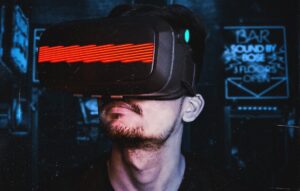How to Use VR to Work From Home

Remember when we all thought we’d return to the office two weeks after the Covid-19 pandemic hit in March 2020? Yeah, me too. But here I am, working from my home office in 2023. And I’m betting that you probably are, too! You and I aren’t the only ones.
According to Forbes, 12.7% of workers are fully remote this year, while 28.2% are in a hybrid workplace. And experts expect that about 22% of the workforce will be fully remote by 2025. So if remote work is the current frontier, how do employers continue to innovate their remote workplace practices to engage employees, boost efficiency, and create a positive culture? At least a part of the answer may lie with virtual reality (VR) technology.
Current VR Technology
Most of us know VR technology from entertainment spaces, like VR headsets that interact with gaming systems. VR technology creates an immersive, computer-generated visual and auditory experience for the user. Currently, most VR hardware options involve a headset or helmet, which covers the user’s full scope of vision and provides audio interaction.
Companies like Meta, Apple, Microsoft, Samsung, and others are all investing in VR hardware and software, driving the market to $59.96 billion in 2022, with an expected compound annual growth rate of about 27.5% from 2023 to 2030.
Augmented Reality & Mixed Reality
You may have also heard the terms augmented reality (AR) and mixed reality (MR). Augmented reality uses similar technology to VR. But whereas VR technology immerses the user in a completely computer-generated experience, AR technology augments reality by projecting computer-generated images on the user’s view of reality. MR combines elements of both AR and VR.
What is the Metaverse?
All of this VR, AR, and MR technology connects users to what’s called the metaverse. McKinsey & Company describes the metaverse as “an evolution of today’s internet—something we are deeply immersed in, rather than something we primarily look at.” Essentially, the metaverse converges existing AI, VR, AR, cryptocurrency, spatial computing technologies, and more to create an immersive experience featuring real-time interactivity and user agency.
These technologies have incredible potential to engage users for entertainment purposes but also in business settings.
Industries using VR
Multiple industries are already using VR technology applications to augment workplace capabilities. Examples include:
- Healthcare: Medical schools are using VR technology to train students for surgery. Current use in medical schools shows that VR learning increases student engagement, retention, and learning speed.
- Real Estate: VR tech has found multiple applications in commercial real estate settings to develop virtual showrooms for international customers.
- Architecture, Engineering, and Construction: AEC firms use VR technology to create digital twins of current and future designs to improve construction, remodeling, and other facility management challenges.
- Manufacturing: The digital twins used in AEC applications can also monitor manufacturing facility environments to improve safety and efficiency.
- Retail: Large clothing retailers like Nike are using VR experiences to create digital communities of clothing enthusiasts by competing for NFTs and viewing 3D products.
VR has many uses in engaging customer bases and augmenting employees’ and students’ abilities to connect and learn globally. And if the rapid growth of technological developments in the 21st century are any indication, those advancements will only improve. But what about augmenting the work of employees who work from home?
Work-from-Home VR Applications
Businesses can use VR technology to improve company culture, provide immersive training experiences, and create more focused work environments in the metaverse. Applications include:
- Collaborative Environments: Companies like Meta and Microsoft have created VR apps facilitating virtual meetings, events, and presentations. Meta’s Horizon Workrooms allows users to create VR avatars that can interact in meetings and presentations and feel like they’re in the same room.
- Productivity Apps: Some apps, like Immersed and vSpatial, create a virtual desktop or monitor that display every aspect of the desktop all at once and then allows you to narrow your focus, versus the tabs feature on most real-life desktops. In fact, one writer for Wired wrote about his interesting experience switching entirely to a VR desktop using Immersed.
- Employee Training: Especially for those jobs with technical skill requirements, businesses can teach employees how to use specific equipment and technologies from their homes instead of engaging in person, reducing companies’ training overhead.
- Remote Site Visits/Inspections: For facility managers, performing virtual walk-throughs of their facilities will eliminate traveling needs and allow them to handle facility needs more quickly.
- Product Development: For design and development teams spread worldwide, using VR technology to collaborate to interact with products at scale.
Of course, implementing VR technology across an entire company has many challenges, including extensive hardware requirements, user training, and security concerns. Despite these challenges, VR meets the distinct needs of a global workforce to build meaningful communities, collaborate effectively, and help employees upskill. As VR hardware and software continues to improve, its applications and ability to augment remote workers will become more attainable for all types of companies.
Check out our blog for other relevant industry topics, or our podcast on YouTube, the audio version, or wherever you get your podcasts.
